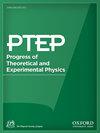On thermal transition in QCD
IF 8.3
4区 物理与天体物理
Q1 Physics and Astronomy
引用次数: 0
Abstract
We describe how the general mechanism of partial deconfinement applies to large-N QCD and the partially-deconfined phase inevitably appears between completely-confined and completely-deconfined phases. Furthermore, we propose how the partial deconfinement can be observed in the real-world QCD with the SU(3) gauge group. For this purpose, we employ lattice configurations obtained by the WHOT-QCD collaboration and examine our proposal numerically. In the discussion, the Polyakov loop plays a crucial role in characterizing the phases, without relying on center symmetry, and hence, we clarify the meaning of the Polyakov loop in QCD at large N and finite N. Both at large N and finite N, the complete confinement is characterized by the Haar-random distribution of the Polyakov line phases. Haar-randomness, which is stronger than unbroken center symmetry, indicates that Polyakov loops in any nontrivial representations have vanishing expectation values, and deviation from the Haar-random distribution at higher temperatures is quantified with the loops. We discuss that the transitions separating the partially-deconfined phase are characterized by the behaviors of Polyakov loops in various representations. The lattice QCD data provide us with the signals exhibiting two different characteristic temperatures: deconfinement of the fundamental representation and deconfinement of higher representations. As a nontrivial test for our proposal, we also investigate the relation between partial deconfinement and instanton condensation and confirm the consistency with the lattice data. To make the presentation more easily accessible, we provide a detailed review of the previously known aspects of partial deconfinement.关于 QCD 中的热转变
我们描述了部分去约束的一般机制如何适用于大 N QCD,以及部分去约束相如何不可避免地出现在完全约束相和完全去约束相之间。此外,我们还提出了如何在具有 SU(3) 轨则群的真实 QCD 中观察到部分去约束。为此,我们采用了 WHOT-QCD 协作获得的晶格构型,并对我们的建议进行了数值检验。在讨论中,波里雅科夫环在表征相位方面发挥了关键作用,而无需依赖中心对称,因此我们澄清了波里雅科夫环在大 N 和有限 N 的 QCD 中的意义。哈尔-随机性比不破中心对称性更强,它表明任何非三维表示的波里雅科夫环具有消失的期望值,而在更高温度下偏离哈尔-随机分布的情况可以用环量化。我们讨论了分离部分解约束相的跃迁是由各种表征中的波里雅科夫环的行为所表征的。格子 QCD 数据为我们提供了表现出两种不同特征温度的信号:基本表征的解约束和更高表征的解约束。作为对我们建议的一个非简单测试,我们还研究了部分去抵消和瞬子凝聚之间的关系,并确认了与晶格数据的一致性。为了使介绍更容易理解,我们详细回顾了部分去协方性的先前已知方面。
本文章由计算机程序翻译,如有差异,请以英文原文为准。
求助全文
约1分钟内获得全文
求助全文
来源期刊

Progress of Theoretical and Experimental Physics
PHYSICS, MULTIDISCIPLINARY-PHYSICS, PARTICLES & FIELDS
CiteScore
12.00
自引率
5.70%
发文量
148
审稿时长
17 weeks
期刊介绍:
Progress of Theoretical and Experimental Physics (PTEP) is an international journal that publishes articles on theoretical and experimental physics. PTEP is a fully open access, online-only journal published by the Physical Society of Japan.
PTEP is the successor to Progress of Theoretical Physics (PTP), which terminated in December 2012 and merged into PTEP in January 2013.
PTP was founded in 1946 by Hideki Yukawa, the first Japanese Nobel Laureate. PTEP, the successor journal to PTP, has a broader scope than that of PTP covering both theoretical and experimental physics.
PTEP mainly covers areas including particles and fields, nuclear physics, astrophysics and cosmology, beam physics and instrumentation, and general and mathematical physics.
 求助内容:
求助内容: 应助结果提醒方式:
应助结果提醒方式:


